Learning how to start a mental health blog can be a great way to inform and support others who may be struggling with their mental health. It can also be a therapeutic outlet for the blogger. If you invest enough time, you will even be able to start making money with your mental health blog promoting products and services that help your audience.

If you are considering starting a mental health blog, this guide will take you step by step and help you create one. We will cover how to define your mental health blogging goals, choose a niche, register a domain name, set up WordPress, write blog posts, and promote your blog. We will also touch on monetization so that you can do this full-time in the long run.
By the end of this complete guide, you will have everything you need to start your mental health blog & make money online in 2024!
If you have any questions along the way, just drop a comment and I will help you out.
So let us jump right in.
How to Start a Mental Health Blog in 7 Steps
- Define Your Mental Health Blogging Goals
- Choose a Mental Health Niche
- Pick & Register a Blog Domain Name
- Setup WordPress
- Write & Publish Blog Posts
- Promote Your Mental Health Blog
- Monetize & Make Money
1. Define Your Mental Health Blogging Goals
The first step in starting a mental health blog is to define your goals. What is the purpose of your blog? Are you looking to inform and support others? Are you hoping to use your blog as a therapeutic outlet? Are you looking to make money and passive income on the side while you support others? Once you have a clear idea of your goals, you can begin to build your blog around those goals.
What is a Mental Health Blog?
A mental health blog is a blog that focuses on topics related to mental health. This can include personal experiences, tips and advice, mental health resources, and more. Mental health blogs can be a valuable resource for those struggling with mental illness, as well as their loved ones.
Why Start a Mental Health Blog?
There are many reasons why someone might start a mental health blog. For some, it is a way to connect with others who may be going through similar experiences. It can also be a therapeutic outlet for the blogger. Additionally, mental health blogs can help to reduce the stigma surrounding mental illness and provide valuable resources for those struggling with mental health issues.
The benefits of starting a mental health blog include:
- Become an authority in mental health
- Create a valuable resource for those struggling with mental health issues
- Promote mental health products and services that help you make money
- Network with others in the mental health industry.
- Learn about mental health topics
- Develop professional contacts
How much money can you make from Mental Health blogging?
The median ad income of a blog with 100 posts is $2815 per month. Your income potential will be higher if you have more blog posts. You can also promote affiliate products and services that help your audience and sell digital products such as e-books or courses to make even more money.
2. Choose a Mental Health Niche
Now that you have an idea of your goals for your mental health blog, it is time to choose a niche. A niche is a specific focus or topic for your blog.
Why choose a niche?
When you choose a niche, you can focus your content and build an audience of people who are interested in that specific topic. This can help you attract readers and followers who are more likely to engage with your content and become lifelong fans. Additionally, it can make it easier to monetize your blog as you will be able to promote products.
Finding Your Ideal Niche
When choosing a niche, it is important to consider what you are passionate about and what you can offer to your readers that is unique and valuable.
If you are struggling to choose a niche, here are some questions to ask yourself:
- What topics am I passionate about?
- What do I have experience with?
- What do I know that others don’t?
- What can I offer that is unique and valuable?

Here are a few niches for your Mental Health blog to help you find yours:
- Depression
- Anxiety
- Overcoming Phobias
- Therapy
- Grief
- Suicide Prevention
- Substance Abuse
- Eating Disorders
- Mental Health in the Workplace
- Veterans and Mental Health
Examples of Mental Health Blog
Sometimes looking at other mental health blogs will help inspire ideas of your own. Here are some of the most popular mental health blogs:
1. NAMI Blog
This is a blog of the National Alliance of Mental Illness. It covers topics such as racism and trauma. It also helps people who are struggling with mental illness.
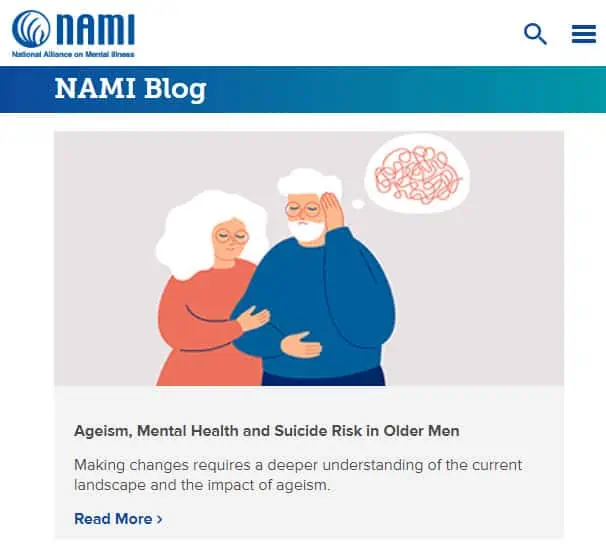
2. Blunt Therapy
This is a mental health blog by a licensed therapist that covers topics such as anxiety, addictions, relationships, and parenting. It also has tips and resources for people who are struggling with mental illness.

3. The Mighty
This blog is a place for people to share their stories about mental illness. It also has articles with tips and advice.
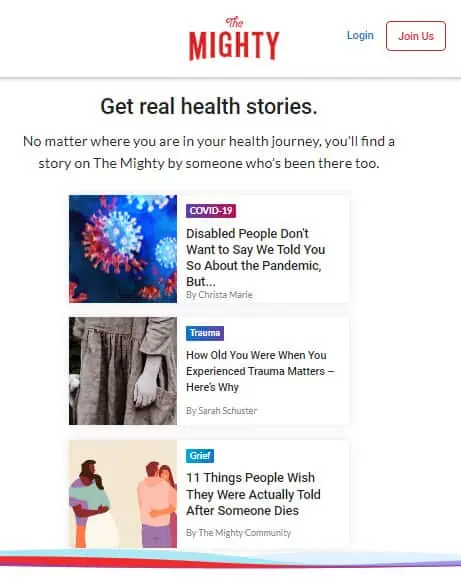
4. Beautiful Voyager
This is a blog by Meredith Arthur. She was diagnosed with a generalized anxiety disorder that caused her to have migraines all her life. The blog has articles and content for other overthinkers such as herself.
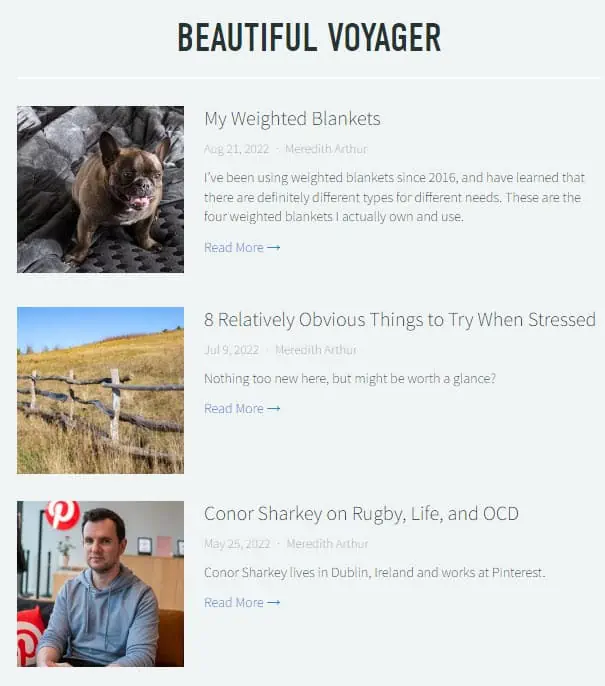
5. My Brain is Not Broken
This blog is by Nathan Smith and is about living with depression and mental health issues.
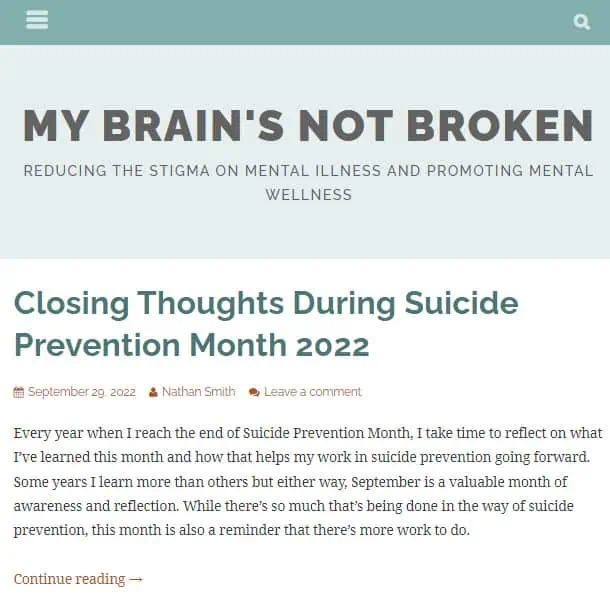
3. Pick & Register a Blog Domain Name
Once you have chosen your niche, it is time to brainstorm a few names for your mental health blog.
We recommend you keep your mental health blog’s name to two words (Example: Blunt Therapy). One of the two words should be a keyword from your niche. The other word can be something that makes your website brandable. For example, our blog teaches people how to make passive income, so we have named it Passive Book.
Here are some of the words that you can mix and match into your blog name:
- Mind
- Therapy
- Mental
- Psych
- Happiness
- Sane
- Sanity
- Bipolar
- Counseling
- Counsel
- Depression
- Bipolar
Use a Business Name Generator to brainstorm the name of your blog.
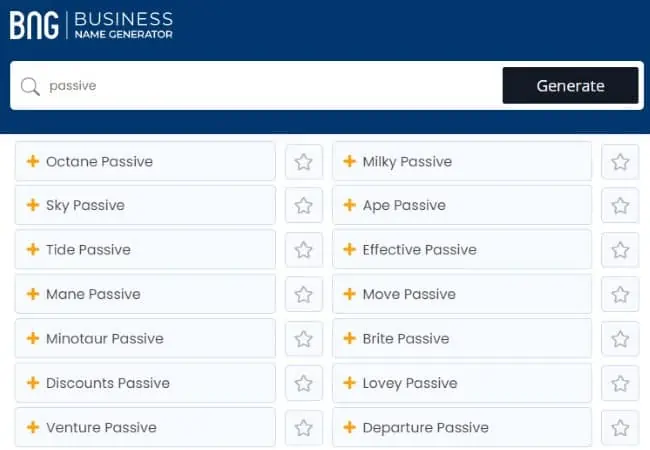
You can also use your own name for your blog. But if you ever plan to sell your website in the future, it is much more difficult to transfer your brand to the buyer when it is your name.
Check Domain Name Availability
After you have brainstormed a few names for your mental health blog, you should check if the .com domain name is available.
A domain name is the web address people will use to find your blog. The domain name is usually your blog name followed by an extension like .com or .net. For example, the domain name of this blog is passivebook.com.
You must check if both the .com domain name and the social media handles are available. You can use Namechk to check the availability of both your domain name and social media handles.
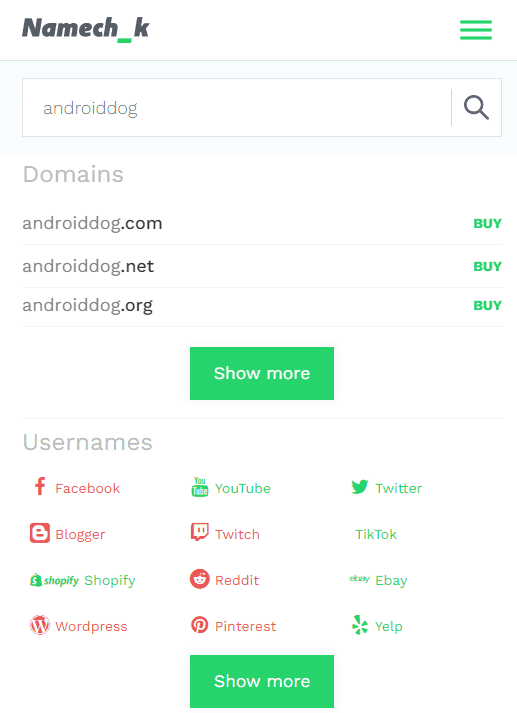
Here are a few things to keep in mind when selecting a domain name:
- Choose a .com domain name. 86% of the internet uses .com, so your visitors are likely to try visiting your blog by typing .com. Avoid other extensions like .net or .org.
- Don’t include hyphens and numbers.
- Do not use words with multiple spellings (for example colour vs color).
- Shorter domain names are better. Try to keep it under 12 characters.
- Spelling & Pronunciation should be easy and intuitive.
- It should be easy to remember.
- Avoid words that can be misread together. For example, therapistjohn.com can be read as Therapist John or The Rapist John.
- Make sure it’s not trademarked or copyrighted by someone else. The AI writing software Jarvis.ai had to rebrand to Jasper.ai because Marvel sued them for the Iron Man reference. Lawsuits will happen once your blog is established.

Register a Domain Name
Once you decide your domain name it is time to register it.
You should register your domain with NameCheap because you will get domain privacy for free. Other providers charge $12 per year for domain privacy. Without domain privacy, your name, home & email address will be accessible to the public.
Step 1: Go to NameCheap. Enter your domain name with the .com extension.
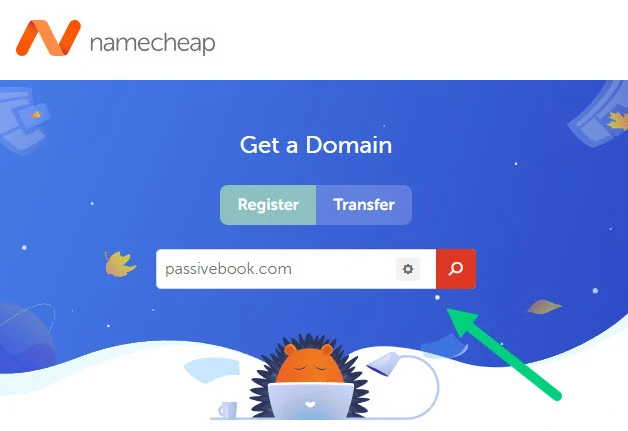
Step 2: Select the .com extension and click the Add to Cart button.
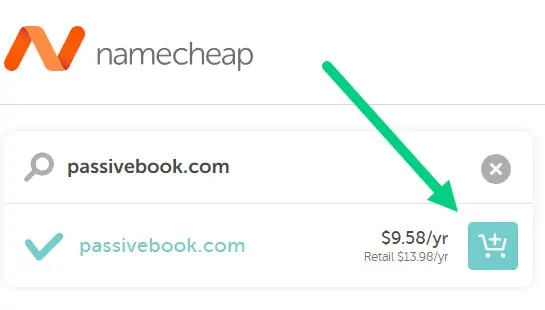
Step 3: After adding the domain to the cart, click on the Checkout button.

Step 4: Enable Domain Privacy that comes for free along with auto-renew. You don’t need any other paid addon.

Step 5: Click on Confirm Order. Pay to complete your purchase.
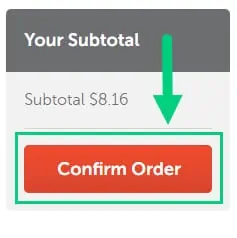
Step 6: Log in to Namecheap and click on Domain List ❶ in the left sidebar and then click Manage ❷ next to the domain you just purchased.
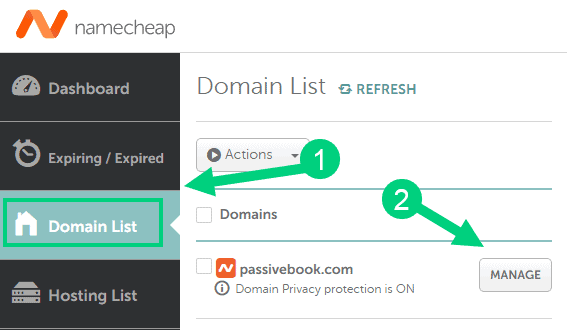
Step 7: Under the Nameservers section, select “Custom DNS” from the dropdown ❶. Then enter the following two nameservers ❷ ns1.bluehost.com and ns2.bluehost.com as shown in the image. Then click the green tick ❸ to save. If you use a hosting provider other than Bluehost, enter their nameserver values in this step instead.
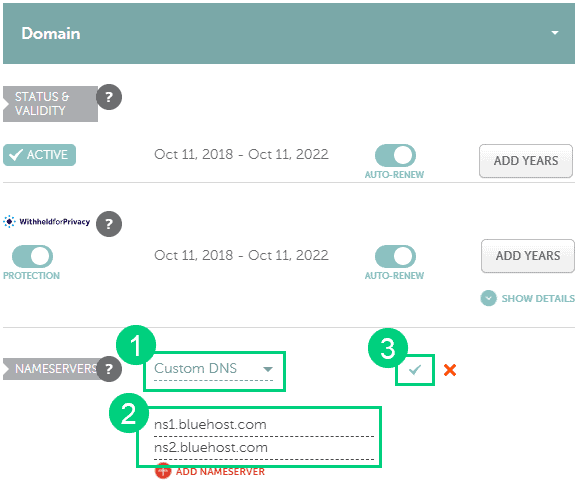
Can I get a free domain name?
Your web hosting provider might give you a free domain name for one year but they charge $12 for domain privacy which is free in Namecheap. From the second year, you will pay for both the domain and privacy which will cost you more than $20+. So it is cheaper to just register your domain with Namecheap from the beginning. Also using different companies for web hosting and domain registration will allow you to easily switch your blog host later without transferring domains.
Can I change the name of my blog later?
You will lose your search engine rankings if you change your blog’s name once it gets links from other websites. It will take as long as a year or more for you to regain the lost traffic. It is possible to mitigate problems by having proper redirects. But you will have to renew both your old and new domains every year. So try to avoid changing your blog’s name once it is established.
4. Setup WordPress
The next step is to get your blog up and running in WordPress. WordPress is a content management system (CMS) that helps you easily create and manage your blog content and website pages.
Why Choose WordPress.org?
There are many blogging platforms but the self-hosted wordpress.org powers 70% of blogs on the internet. 42% of all websites on the internet use WordPress. Here’s why:
WordPress is free and open-source software. This means you can use it for free to create any type of website.

You can install any plugin or theme on your WordPress blog. This allows you to easily customize and extend the functionality of your WordPress blog.
You can make money from your WordPress blog by selling products, advertisements, and affiliate products.
You own your content and website. If you ever want to sell your blog, you can easily do so.
WordPress is used by some of the biggest brands in the world like Facebook, Google, Sony, Disney, Forbes, The Guardian, and many more.
WordPress is easy to use. You can easily create and manage your blog posts with WordPress.
WordPress.org vs WordPress.com
WordPress has two versions:
WordPress.com – This is a free version of WordPress where you can create a blog for free. But it has many limitations like not being able to use Google Adsense or other advertising platforms, and you don’t own your content.
WordPress.org – This is the self-hosted version of WordPress where you can create a blog for free in a hosting of your choice. You can use any plugin or theme, and make money from your blog with advertising, selling products, and affiliates.
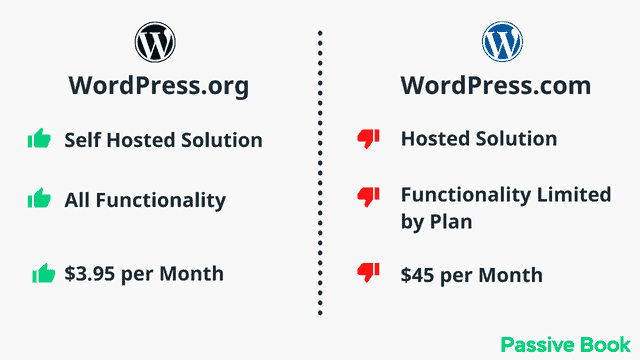
We recommend using WordPress.org for your mental health blog because it will give you all the flexibility that you will ever need.
Why Avoid Free Blogging Platforms
There are many free blogging platforms like Blogger, WordPress.com, Wix, Weebly, and Tumblr. But we don’t recommend using them because it is difficult to get traffic from search engines. It is also difficult to monetize and make money from your blog.
Your blog can also be deleted by the platform without notice. This is very common among Blogger and Tumblr blogs.

How much does it cost to start a Mental Health blog?

It will cost you $2.95 per month to host your WordPress mental health blog in Bluehost. A domain will cost you $12/year. So that is a total of $4.2 per month, which is less than the price of Netflix for all the unlimited features that a self-hosted WordPress blog has to offer.
What to do if you already have a free blog?
You can follow the steps in this guide to start a blog in WordPress and then move all your posts to WordPress using a free import plugin.
Install WordPress in Hosting
The first step to installing WordPress is to choose a web hosting provider for your blog. A web host is a company that provides the technology and services needed for your website or blog to be viewed on the internet. They store all the files and images of your blog. When someone visits your blog, the files are transferred to the visitor’s browser from your web server.
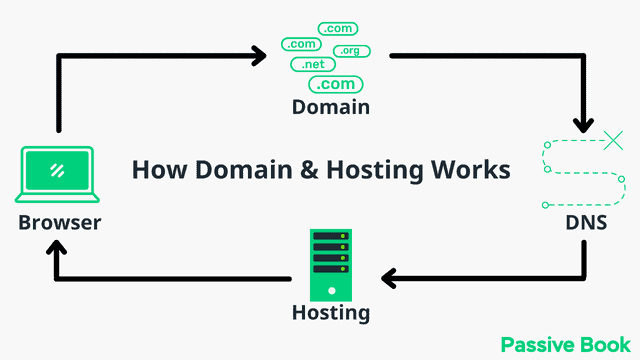
For this guide, we will use BlueHost as our web host. It is a cheap hosting that is extremely easy for beginners to set up. If you use any other web host, the steps will be the same but the user interface may be slightly different.
1. Go to BlueHost using this link to get a special discount. Select WordPress > WordPress Hosting from the top menu.
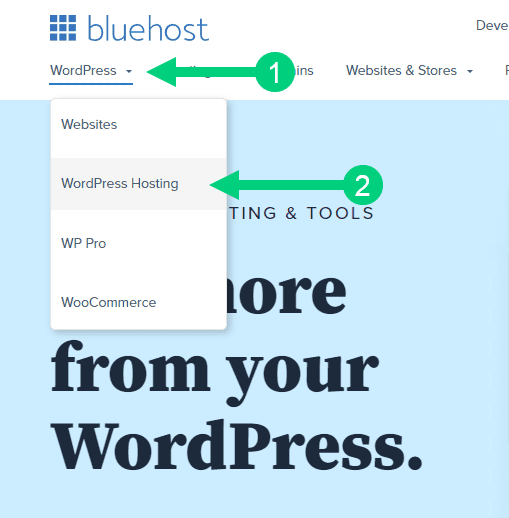
2. Click on the button you see on this page and you will be taken to the pricing section.

3. Select the Basic Plan. You can upgrade to a different hosting plan as you grow.
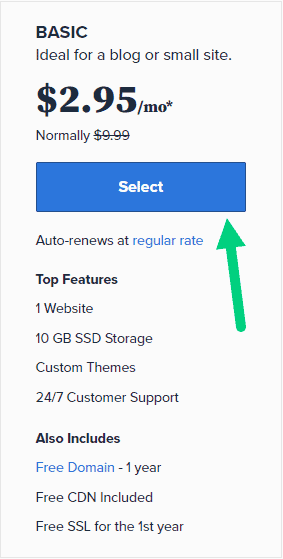
4. If you already have a domain name that you purchased with Namecheap you can put that in the “Use a domain you own” ❶ section. If you don’t have a domain name yet, choose the “Create a New Domain” ❷ to purchase a new domain.
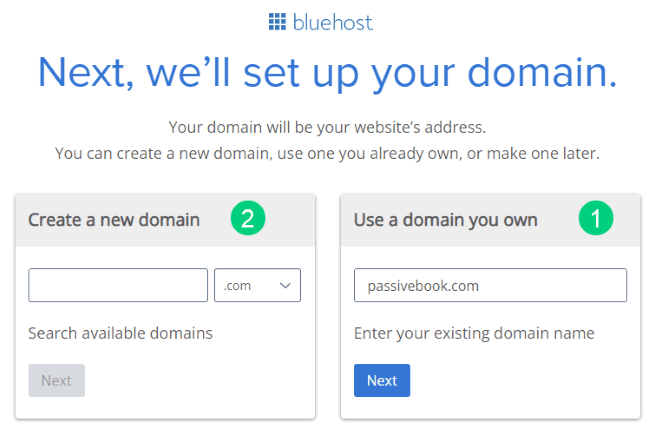
5. In the next screen, enter your information. Uncheck all package extras. If you purchase your domain through Bluehost instead of Namecheap, you may want to enable Domain Privacy. You won’t see the Domain Privacy option if you bought your domain through Namecheap. Namecheap will give you this Domain Privacy for free.
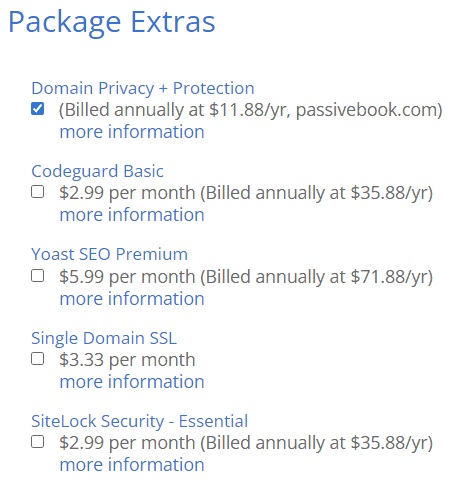
6. Once you have successfully paid, you will be prompted to set a password. Click on the “Create your Password” button.
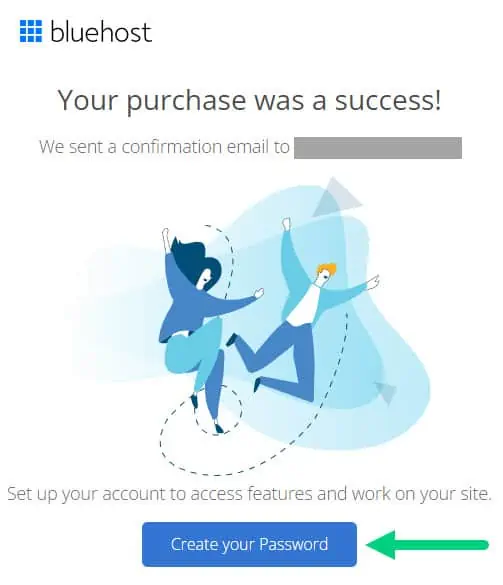
7. Enter your password and create your account. If you lose this password, you can reset it.

8. After you set your password, log in to Bluehost.
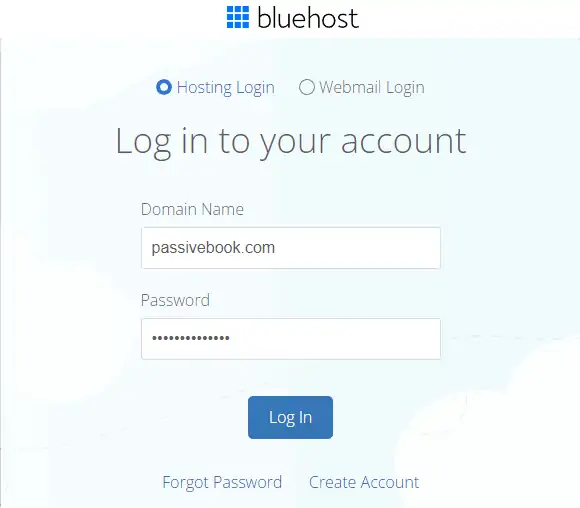
9. Click on the Create your website button on the following screen. This will start a Bluehost Wizard, just click Skip this step wherever possible.

10. On the following page, click “No help needed” or “Skip this step”. We don’t want Bluehost to limit our customization options.
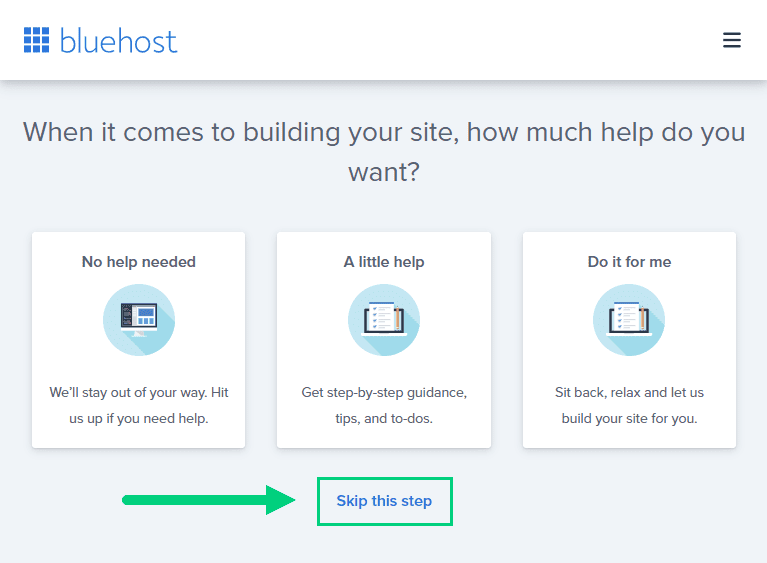
11. On the next page, you will be asked about the purpose of your website. You can choose from any of the available options.
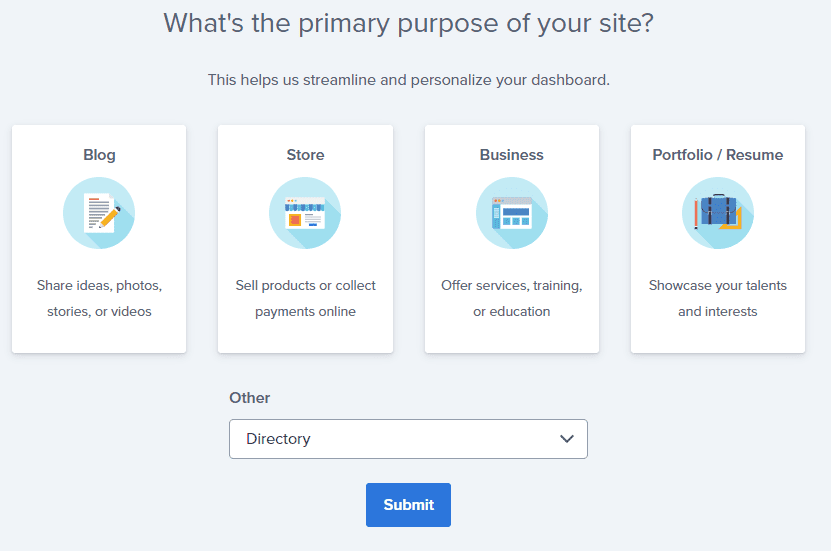
12. On the next page, click Skip this step.

13. On the following page, enter the blog’s name and tagline. You can change this later so feel free to click “Skip this step” or enter something as a placeholder and click Continue.
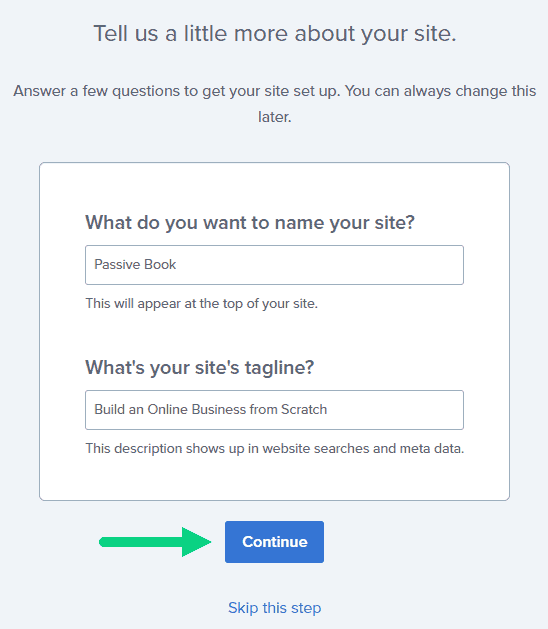
14. Finally you will be asked how you want to build your website. Choose “Limitless customization” to have all the options.
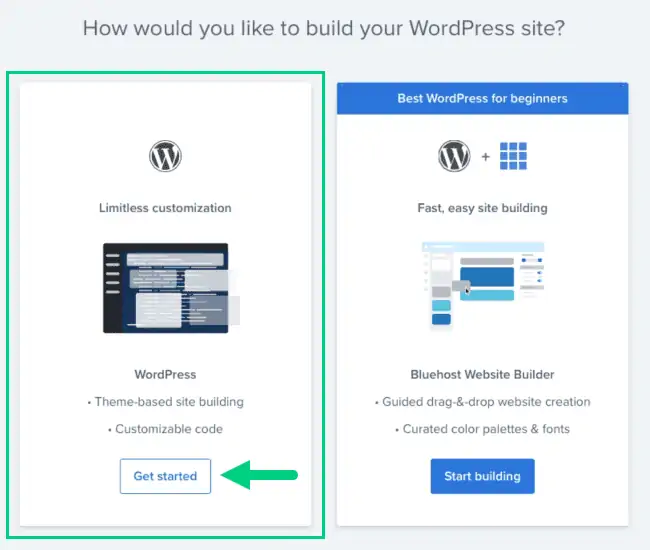
15. You can see your blog by going to yourdomain.com. Go to the Bluehost dashboard and click on the My Sites tab ❶ in the left sidebar and click on the “Manage site” button ❷.

16. Your WordPress site has separate login credentials different from the ones you use to log into Bluehost. You can use this to log in to the WordPress dashboard directly without logging into Bluehost. To get this:
❶ Click on Users on top.
❷ You will be able to see your username and email that you can use to log in to WordPress.
❸ If you click on the three dots you will see the option to Reset your password. ❹
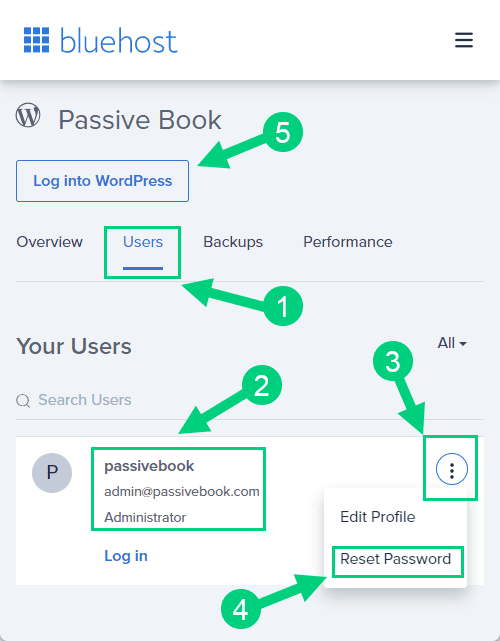
You can log into WordPress from the Bluehost dashboard by clicking the Log in to WordPress button ❺. But it is not recommended you rely on this as your primary login method because you will get locked out of your site if you ever change hosting providers.
17. You will be taken to the WordPress dashboard where you can reset your password ❶. If you don’t like the username Bluehost created for you, you can Add a New User ❷.

18. If you are adding a new user make sure you specify the user role as Administrator ❶. You can log in as the new user and safely delete the default user created by Bluehost.
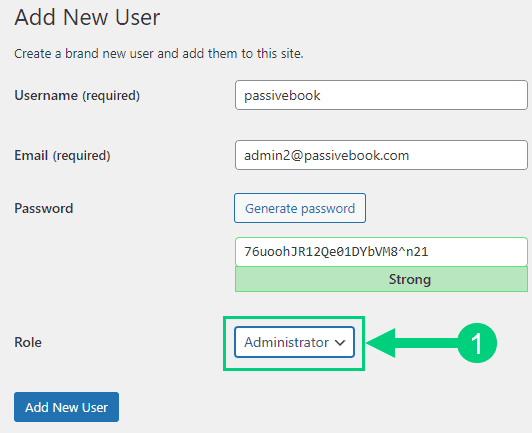
Congratulations! You have successfully set up WordPress.
Configure WordPress
Now that you have the basic version of WordPress installed, it is time to customize it to make it look and feel the way you want.
Login to WordPress Dashboard
The WordPress dashboard is the area where you can manage all your WordPress settings.
You can access it by visiting yourdomain.com/wp-admin.

Here are some of the things you can do on the dashboard:
- Manage your blog posts and pages
- Add new users to your blog
- Change your blog settings
Use the Email and Password you provided during installation to log in to your WordPress dashboard. If you don’t have a password, use the “Lost your password?” to generate a new password.
Install WP Themes
A theme is a collection of files that control the look and feel of your WordPress blog. There are thousands of free and paid themes available for you to use.
Your new WordPress blog will be installed with a default blog theme that doesn’t look very great.
To install a new WordPress Theme:
Go to Appearance > Themes > Add New in your WordPress dashboard.
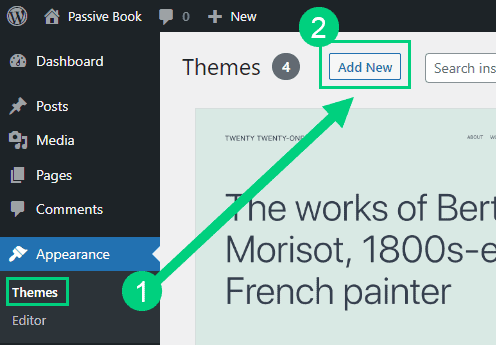
Use the search to find a theme that you like ❶. Before you install the theme, you can see a demo of the theme and learn about its features from the preview screen ❷. If you like the theme, you can install it by clicking the install button ❸. You can also upload a theme from a file on your computer ❹.
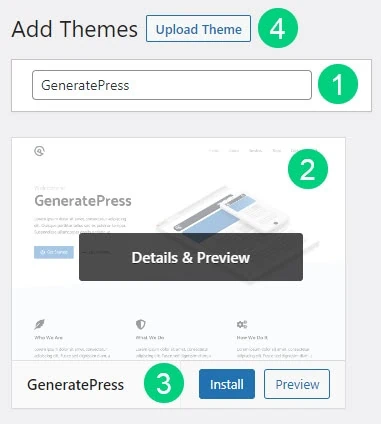
Once installed, click the Activate button to enable the theme.
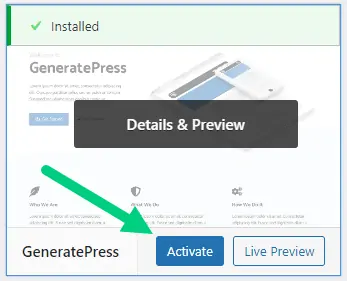
Although you can use a free theme (there are thousands of free themes available), we recommend using a premium theme.
We recommend using a paid theme because they are well-supported by the creators, have better features, and are more reliable. They not only reduce your website’s load time but also help you customize your website to your heart’s desire.
Here are the premium themes we recommend:
There are also several custom-made mental health blog themes. These themes tend to be bloated with poor code which will slow down the performance of your website. We suggest getting one of our recommended themes for a fast website with unlimited customization possibilities.
Install WP Plugins
A WordPress plugin is a software program that extends the functionality of WordPress. There are thousands of free and paid plugins available for you to use.
Too many wordpress plugins can slow down your blog site. So before you install new plugins, it will be worth clearing out any existing plugins that your hosting provider installed by default.
Plugins first need to be deactivated before they can be deleted.
❶ Go to WP Admin > Plugins > Installed Plugins
❷ Click on the checkbox to select all plugins.
❸ Select Deactivate from the drop-down.
❹ Click Apply.
❺ Repeat the above steps but select “Delete” instead of “Deactivate” from the dropdown in ❸ to delete all the deactivated plugins.
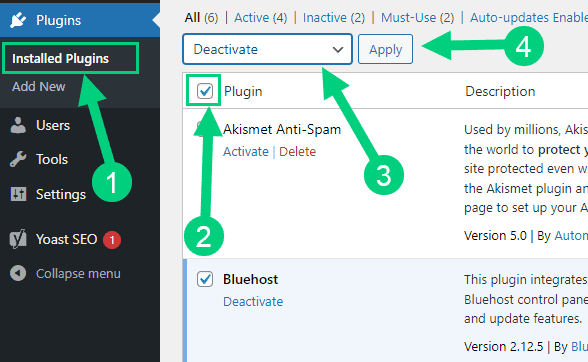
To install new plugins go to the WP Admin > Plugins > Add New.

On the plugins page:
❶ Search for the plugin you want in the search bar
❷ Click Install Now. Once you install the plugin, you must also activate the plugin for it to be enabled.
❸ If you are installing a paid plugin you can upload the plugin instead.

There are many different plugins that you can install, but here are the ones which we recommend:
Backup Plugin: A WordPress Backup Plugin helps you back up your website’s data. This is important because if something goes wrong with your website, you can use the backup to restore your website to its previous state.
Recommended Plugin: WPVivid (paid) or UpdraftPlus (free).
SEO Plugin: A WordPress SEO Plugin helps you improve your website’s search engine ranking. This means that your website will be higher up in the search engine results pages (SERPs) when someone searches for a term related to your blog.
Recommended Plugin: RankMath (paid).
Google Analytics Plugin: A WordPress Google Analytics Plugin helps you track the number of visitors to your website, where they came from, and what pages they visit. This information helps you understand how people are using your website and makes it easier to improve your website’s performance.
Recommended Plugin: RankMath (paid) or GA Google Analytics (free).
Cache Plugin: A WordPress Cache Plugin helps improve the performance of your website. A faster website means that people will be able to access your content quicker.
Recommended Plugin: WP Rocket (paid).
Page Builder Plugin: A WordPress Page Builder Plugin helps you create custom pages for your website. It allows you to create pages that look different from the standard WordPress pages.
Recommended Plugin: Thrive Architect (paid).
Security Plugin: A WordPress Security Plugin helps you protect your website from hackers and malware. If someone hacks your website, they can steal your website’s data or use it to launch an attack against other websites. A security plugin helps prevent that from happening.
Recommended Plugin: Wordfence (free).
Social Media Plugin: A WordPress Social Share Plugin helps you share your website’s content on social media websites. It helps you increase the number of people who see your content.
Recommended Plugin: Easy Social Share Buttons (paid).
Contact Forum Plugin: A WordPress Forum Plugin helps you add a forum to your website. It allows your readers to contact you.
Recommended Plugin: bbPress (free).
Customize WordPress
Once you have installed your theme and plugins, it is time to customize the wordpress blog platform:
Change Colors, Fonts & Spacing
You can set the font, colors, and spacing by going to Appearance > Customize in your WordPress dashboard. Premium themes like GeneratePress allow you to customize every aspect of your blog.
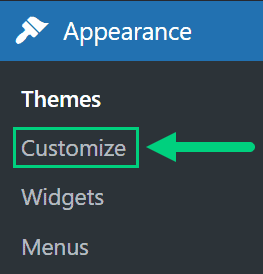
Check out our Blog Fonts & Typography guide to choose the right font and typography settings for your blog.
Add Your Logo
Get a logo designed for your blog from Fiverr. Then set the logo of your blog by going to Appearance > Customize in your WordPress dashboard. A logo is not required for a successful blog but it can definitely help appeal to your target audience.

Change Favicon
Favicon is the image that appears in the browser tab and bookmarks. Set the Favicon from the Appearance > Customize section of the WordPress dashboard.

Create Menus
The header and the footer menu can be set from the Appearance > Menus in your WordPress blog dashboard.

You can nest menu items so that it appears as a dropdown menu ❶. You can use the menu as your primary or secondary navigation menu ❷. Don’t forget to save your menu ❸.
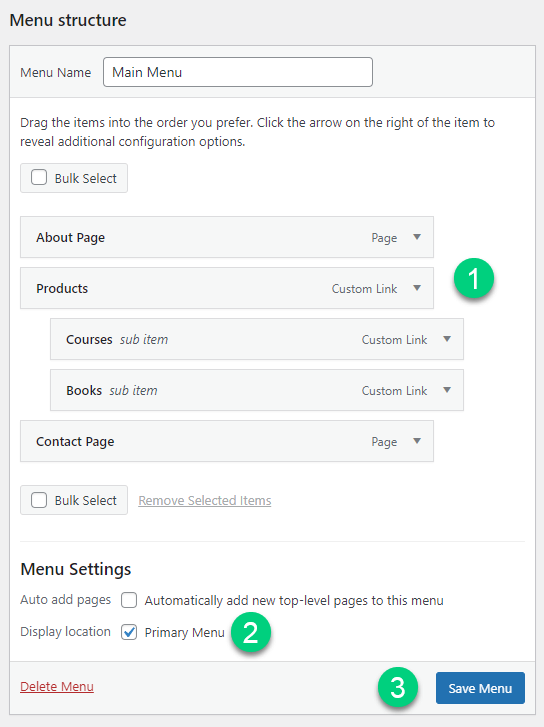
Create Widgets
If you have a sidebar, you can add widgets to it. Go to Appearance > Widgets in your WordPress admin dashboard.
Check out the list of the most useful Blog Widgets and how to add them to your blog.
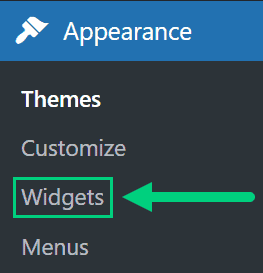
Set Title & Tag Line
The next step is to change your General Settings. Go to Settings > General in the WordPress Admin area.
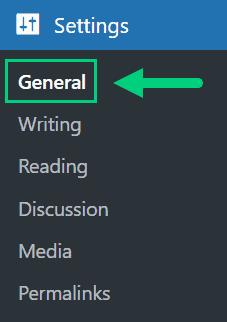
You can set your Site Title, Tagline, and Time Zone from this screen.
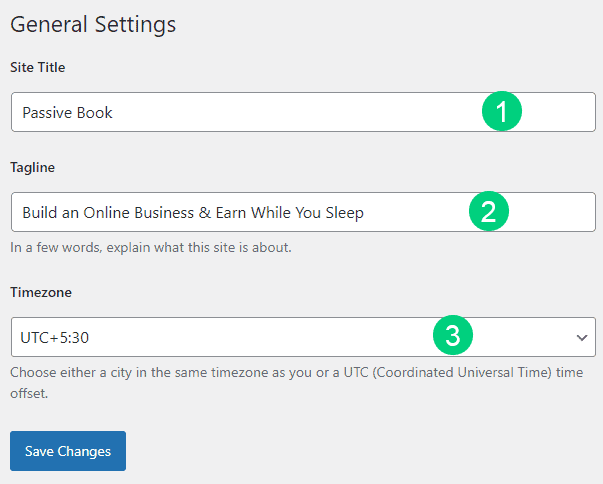
Set Permalinks
The ideal URL structure for SEO is yourdomain.com/sample-post. Set your permalink structure by going to Settings > Permalinks in your WordPress blog dashboard.
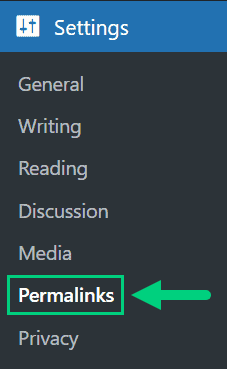
Select the “Post name” radio button and save changes.
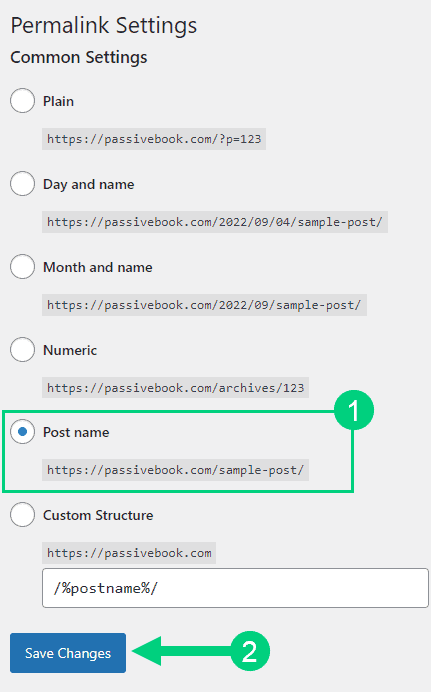
Enable Search Visibility
Chances are you want your blog to show up on Google so people can find you. Go to Settings > Reading in your WordPress dashboard.

To get search engine traffic, ensure the checkbox “Disable search engines from indexing this site” is Unchecked. You can find this option in Settings > Reading. Most of the time this should be unchecked by default but if it is not, then uncheck it to ensure your site gets traffic from search engines.
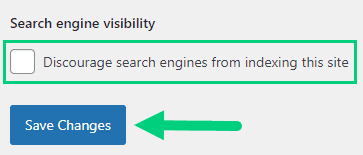
Adjust Comment Settings
Next, you will want to change the Discussion Setting (aka Comments). Go to Settings > Discussion in your WordPress admin area.
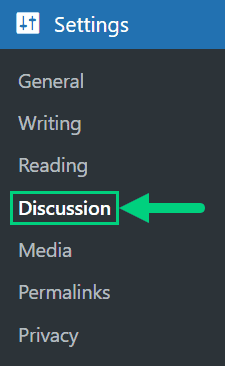
❶ You may want to enable or disable comments on this page. You can also disable pingbacks and enable comment moderation.
❷ You can also set comment approval settings.

If you want to design your blog further, check out our dedicated guide on blog design which has all our best blog design recommendations.
Create Static Pages
There are a few essential pages that you need to create for your mental health blog before you can start blogging.
Use pages in WordPress to add static content. Go to WP Dashboard > Pages > Add New.
- Write the headline of your content.
- Populate the body content
- Click the publish button.
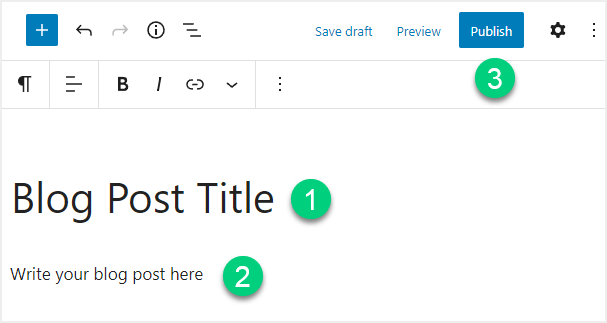
You may want to create the following pages:
Home Page
A home page is the main page of your website. It is the page that people see when they first visit your website. The home page usually contains a brief description of your website, as well as links to the other pages on your website.
You can create a professional home page for your mental health blog using a page builder like Thrive Architect.

About Page
An about page is a page that tells people about you and your website. It is the page that people will go to if they want to learn more about you and your work. The about page should contain a brief description of who you are, what you do, and why you started your website.

Contact Page
A contact page is a page that allows people to contact you. It is the page that people will go to if they want to send you an email, ask you a question, or leave a comment. The contact page should contain your email address, as well as a form that people can use to contact you.
Use contact form plugins like Fluent Forms to create the form on your contact page.
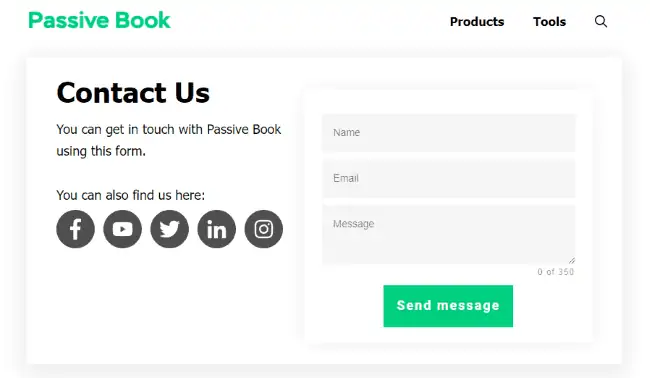
Privacy Policy
A privacy policy page tells people how you will use their personal information. It is the page that people will go to if they want to know how you will use their email address, their name, or their credit card information. The privacy policy should contain a brief description of how you will use the information that people provide to you.
WordPress generates its own privacy policy for you. But you can also use a tool like Termly to generate your own privacy policy.
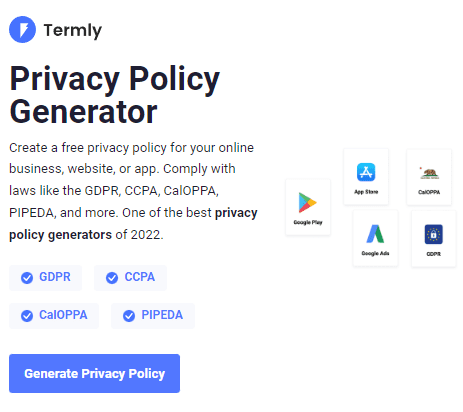
Terms of Service
A terms of service is a page that tells people the rules of your website. It is the page that people will go to if they want to know what they can and cannot do on your website. The terms of service should contain a brief description of the rules that you have for your website.
Use a terms & conditions generator like Termly to create it.
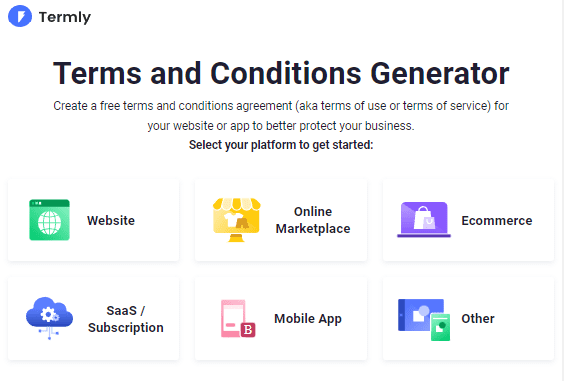
5. Write & Publish Blog Posts
Now that you have your mental health blog set up, it’s time to write and publish your first blog post. To craft the perfect blog post, check out our in-depth guide on How to Write A Blog Post. Here we will go over specific tips for a mental health blog.
1. Brainstorm Topics
You should brainstorm 100 topic ideas for your mental health blog. This will ensure that you always have content to write about in your mental gealth blog.
The goal is to find topics for your mental health blog that your audience is searching for in Google. The type of content you write on your mental health blog will depend on your specific niche. You can potentially cover the following topics on your mental health blog:
- How to cope with mental health issues
- How to find a therapist
- How to talk to your family about mental health
- How to deal with anxiety
- How to deal with depression
There are a few ways to brainstorm specific content:
Look at Competitors
Look at other mental health blogs in your niche and see what type of content they are writing about. You can find your competitors by doing a simple Google search of your keyword. The blogs that appear on top are your top competitors.
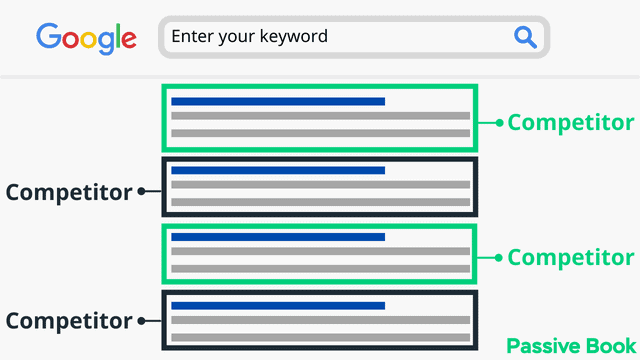
Do Keyword Research
You can also use a keyword research tool to identify topics to write about. A keyword research tool will tell you how many people are searching for a particular keyword in Google. You can use KeywordTool.io or Uber Suggest to do keyword research.
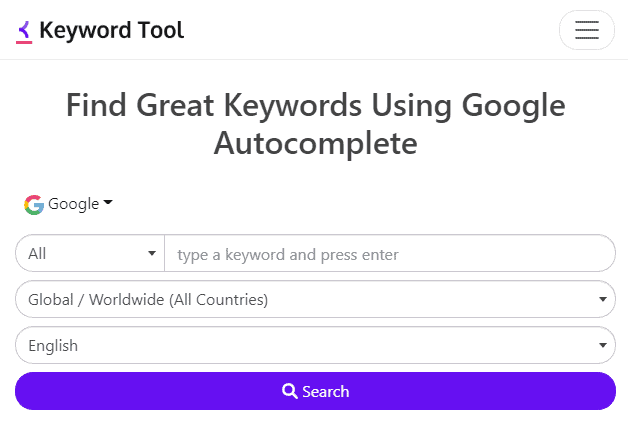
Community & Forums
You can also join relevant forums and communities to see what type of questions people are asking. You can use Google to find relevant forums in your niche. You can spin off questions being asked in these forums into blog posts.
2. Create an Editorial Calendar
An editorial calendar is a schedule of when you will publish your blog posts. This will help you stay organized and ensure that you are publishing content regularly.
Your editorial calendar should include the following information:
- Title of Blog Post
- Publish Date
- Keyword
Download Content Calendar Template

Steal our exclusive content calendar template. Have it delivered directly to your inbox:
There are many software and tools that you can use to create an editorial calendar for your mental health blog.
Trello is a free online tool that you can use to create an editorial calendar. It allows you to create boards, lists, and cards to help you organize your content.
Google Sheets is a free online spreadsheet that you can use to create an editorial calendar.
3. Write a Blog Post
Once you have chosen a topic for your mental health blog post, it’s time to start writing the post.
When writing your mental health blog post, you want to make sure that you are providing value to your audience. Ask yourself, “What problem is my audience trying to solve?” and “How can I help them solve it?”
Your mental health blog posts should be at least 1,000 words. This will help you rank higher in Google and will provide more value to your audience.
Personal Stories
Personal stories or experiences related to mental health involve sharing personal narratives and insights about one’s own mental health journey. This type of blog post can help to destigmatize mental health and provide a sense of relatability and connection for readers who may be going through similar experiences.
Here are a few examples:
- “My Journey with Anxiety: How I Learned to Manage It”
- “Living with Bipolar Disorder: A Personal Perspective”
- “Overcoming Depression: My Story of Hope and Healing”
- “My Experience with PTSD and How I Coped”

Be honest and authentic in your writing. Share specific examples and details to make your story relatable and engaging for readers. Consider the potential impact of your story on others, and be mindful of any sensitive information you may be sharing. Seek feedback from a therapist or mental health professional before publishing your post.
Information & Resources
This post involves sharing factual information and resources on different mental health conditions, such as symptoms, causes, treatments, and support options. This type of blog post can help to educate readers and provide them with the information they need to better understand and manage their own mental health. You can write about mental illness and mental disorders.
Examples of blog post titles in this category could include:
- “Understanding Schizophrenia: Symptoms, Causes, and Treatments”
- “Managing Borderline Personality Disorder: Tips and Resources”
- “Depression 101: Understanding the Symptoms and Finding Help”
- “An Overview of Obsessive-Compulsive Disorder (OCD)”

Make sure to research and provide accurate, up-to-date information on the condition. Include a list of resources and links for readers to access further information and support. Be mindful of the language and tone you use when discussing mental health conditions to avoid stigmatizing or pathologizing them.
Tips & Strategies
Tips and strategies for managing and improving mental health involve sharing practical advice and techniques for managing and improving mental well-being. These types of posts can provide readers with actionable steps they can take to improve their own mental health.
Here are a few examples:
- “10 Simple Ways to Practice Self-Care and Boost Your Mood”
- “Meditation for Beginners: How to Get Started”
- “Exercise and Mental Health: The Surprising Benefits of Physical Activity”
- “How to Build Resilience and Bounce Back from Life’s Challenges”
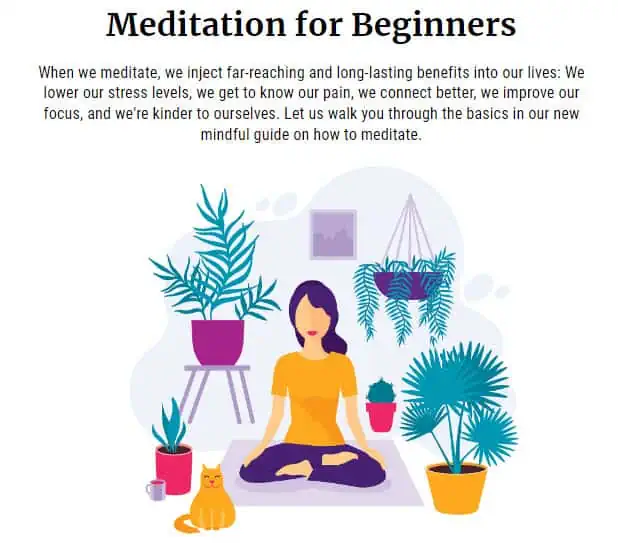
Provide specific, actionable tips and strategies that readers can implement in their own lives. Include examples and anecdotes to illustrate the effectiveness of the tips and strategies you’re sharing. Consider including information on the scientific evidence supporting the tips and strategies you’re sharing.
Reviews
Reviews of mental health books, apps, and other resources involve providing an evaluation and critique of different mental health-related resources, such as books, apps, podcasts, and websites. This type of blog post can help readers to discover new resources and make informed decisions about which ones to use.
Here are a few examples:
- “Book Review: “The Power of Now” by Eckhart Tolle: A Must-Read for Anyone Struggling with Anxiety and Stress”
- “App Review: Headspace: A Beginner’s Guide to Mindfulness Meditation”
- “Podcast Review: The Anxiety Coaches Podcast: A Valuable Resource for Managing Anxiety”
- “Website Review: Mindful.org: An Excellent Resource for Mindfulness and Mental Well-being”

Be honest and provide a balanced evaluation of the resource. Include information on the target audience for the resource and how it may or may not be useful for different types of people. Provide specific examples from the resource to support your evaluation.
Interviews
This post involves interviewing mental health professional or someone who has struggled with or live with someone who had a specific mental health issue. This type of blog post can provide readers with valuable insights and perspectives on different aspects of mental health.
Here are a few examples:
- “Interview with a Psychiatrist: Understanding Medications for Mental Health”
- “Living with Schizophrenia: An Interview with a Person with Lived Experience”
- “A Therapist’s Perspective on Managing Trauma”
- “A Survivor’s Story: Overcoming Eating Disorders”

Prepare a list of questions in advance and be mindful of the time you have for the interview. Be respectful and sensitive in your questioning and avoid asking personal or invasive questions.
Allow your interviewee to speak openly and authentically without interrupting or pushing them to say something specific.
Opinion Posts
Opinion pieces involve expressing an opinion on a current issue or trend in mental health and providing an analysis and perspective on it. This type of blog post can help to engage readers in important conversations and raise awareness about important topics in mental health.
Here are a few examples:
- “Why We Need to Talk More About Suicide Prevention”
- “The Importance of Diversity and Inclusion in Mental Health Care”
- “The Mental Health Consequences of the COVID-19 Pandemic”
- “The Urgency of Addressing Climate Change and Its Impact on Mental Health”
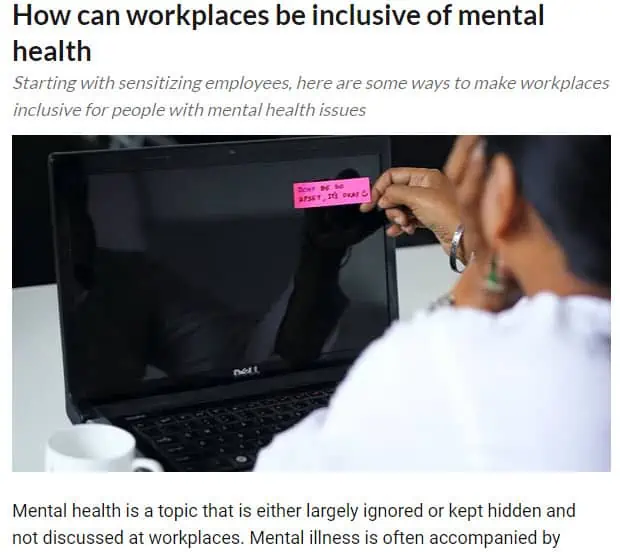
Make sure to research and provide accurate, up-to-date information on the issue or trend. Be clear and concise in your opinion and provide evidence and examples to support it. Be respectful and considerate of different perspectives and opinions on the issue or trend.
Mental Health News & Research
You can share news, recent developments, and research findings in the field of mental health with readers. This type of blog post can help to keep readers informed and up-to-date on important developments in mental health.
Here are a few examples:
- “New Research Finds a Link Between Social Media Use and Depression”
- “Breaking News: FDA Approves New Medication for PTSD”
- “Recent Study Shows the Effectiveness of Mindfulness-Based Therapy for Anxiety”
- “New Guidelines Released for the Treatment of Major Depressive Disorder”
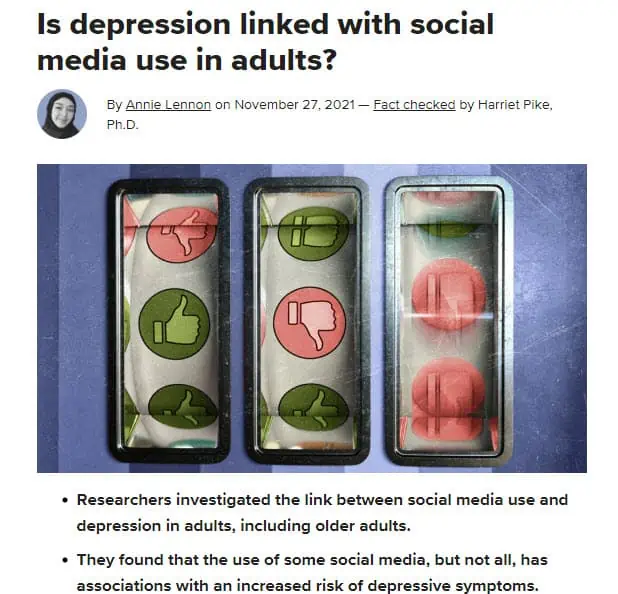
Make sure to provide accurate, up-to-date information on the news or research findings. Include a summary of the main findings, as well as any limitations or implications of the research.
Provide links to the sources of the news or research findings for readers who want to learn more.
List Posts
One of the popular types of posts you can write is a list post. You can write a post providing a list of different self-care practices and activities that readers can use to improve their mental well-being. This type of blog post can provide readers with practical, easy-to-implement suggestions for taking care of their mental health.
Here are a few examples:
- “10 Simple Self-Care Practices for Better Mental Health”
- “5 Mindfulness Exercises to Try Today”
- “7 Ways to Boost Your Mood and Reduce Stress”
- “The Power of Gratitude: 10 Ways to Incorporate It into Your Daily Routine”

Provide a variety of different self-care practices and activities for readers to choose from. Include a brief explanation of why each practice or activity is beneficial for mental well-being. Provide tips and suggestions for how to incorporate self-care practices and activities into daily life.
Write 5x Faster with AI
You can write your new blog post at 5x speed using the AI writing software Jasper. I was able to write over a hundred blog articles in 3 months using Jasper. This blog article you are reading right now was written with the help of Jasper. AI will not only help you write blog posts fast but also with higher quality.
Jasper can write plagiarism-free blog content, articles, social media content, emails, and ad copy. All you have to do is provide a few inputs on what you want and Jasper will do all the hard work of creating the blog content for you. No more writer’s block.
Check out the video below to see Jasper in action:
Try Jasper for free using the links on this page and get 10,000 bonus credits you can use to start writing your first articles.
Once you sign up for Jasper I recommend you spend some time going through the tutorial videos in the Jasper Bootcamp to truly unlock the power of this amazing software.
Check out our guide on How to Write a Blog Post Fast in 15 mins Without Losing Quality for more tips to write fast.
Outsource Writing
If you don’t have time to write the mental health blog post yourself, you can outsource it to a freelance writer.
There are many websites where you can find freelance writers, such as:
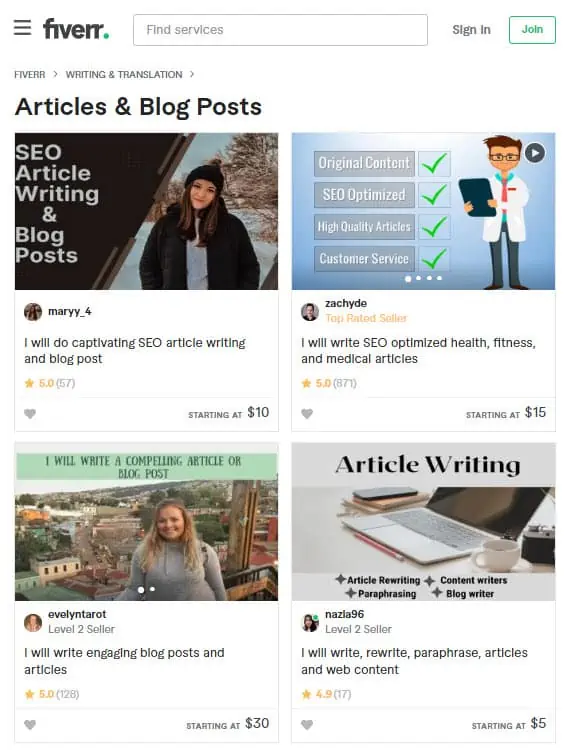
4. Add Images
Adding images to your mental health blog posts will make them more visually appealing and will help break up the text.
You want to make sure that you are using high-quality images that are relevant to your blog post.
You can find free stock photos on sites:
Free Options: Pixabay, Pexels, Upsplash
Paid Options: Deposit Photos, Shutterstock, iStock, Getty Images, 123rf.
You can edit your images in Canva. If you get Canva Pro then you will have access to even more editing features and a large library of stock images.
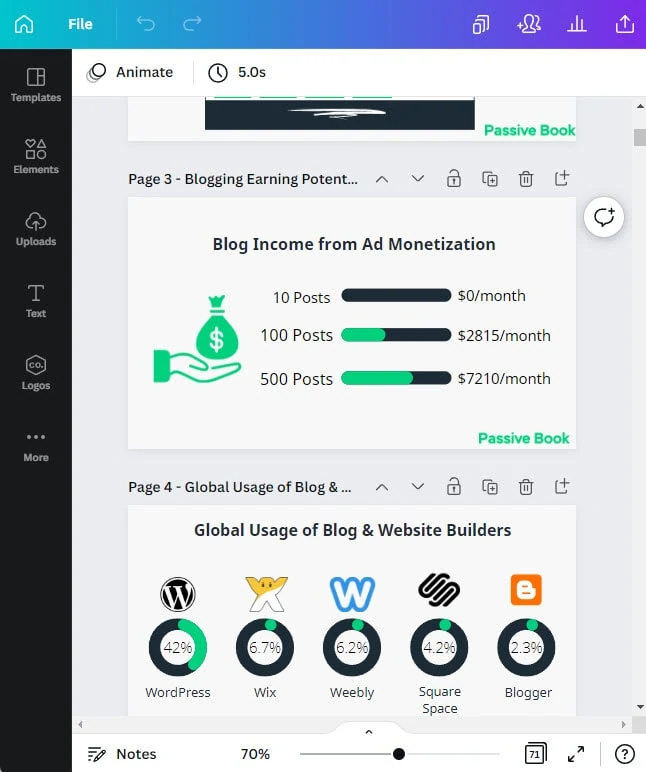
6. Promote Your Mental Health Blog
Once you have published your mental health blog post, it’s time to start promoting it so you get traffic to your blog.
There are many ways that you can promote your mental health blog posts:
Search Engine Optimization (SEO)
Once you have written your mental health blog post, it’s time to optimize it for SEO.
There are a few things you can do to optimize your mental health blog post for SEO:
- Add Keyword in Title
- Add Keyword in Headings
- Add Keywords throughout the blog post
- Add Keyword in the meta description
- Add Keyword in URL
- Add Keyword in Image file name and alt text
- Internal link to other posts
- Get external links from other authority websites
Many factors go into SEO, and it can be a bit confusing to figure out where to start. You can master the more advanced SEO tactics by checking out our SEO Resources.

You can ensure you get the basics of SEO right, by completing the recommendations given by the RankMath plugin.
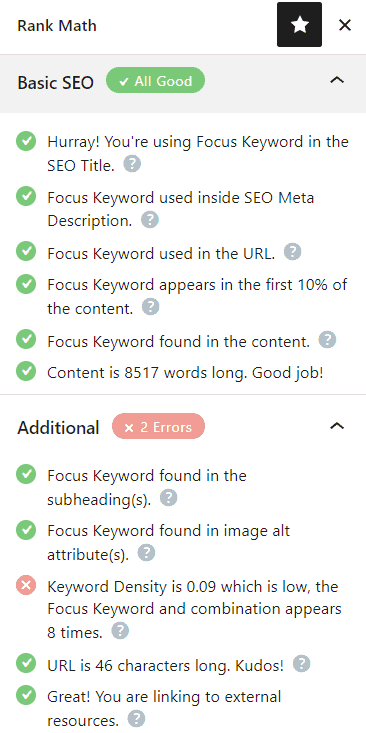
Social Media
Share your mental health blog post on social media sites like Twitter, Facebook, and LinkedIn.
You can also use social media to promote your amazing mental health blog by joining relevant Facebook groups and participating in discussions.
Email Marketing
You should start collecting your visitor’s emails using an opt-in form to build your email list. Once you have a list of email subscribers you can promote your mental health blog post to your subscribers. When you create a paid course or ebook in the future, you can sell this to your email subscribers.

You can use the Thrive Leads plugin to build opt-in forms to collect email addresses. You can then connect the opt-in form to an email marketing service like Active Campaign to send out the emails.
Check out our Email Marketing resources to learn more.
Guest Posting
Guest posting is when you write a blog post for another website in your niche. This is a great way to get exposure to your mental health blog and to build relationships with other mental health bloggers in your niche.
When you guest post, make sure that you include a link back to your blog in your author bio.
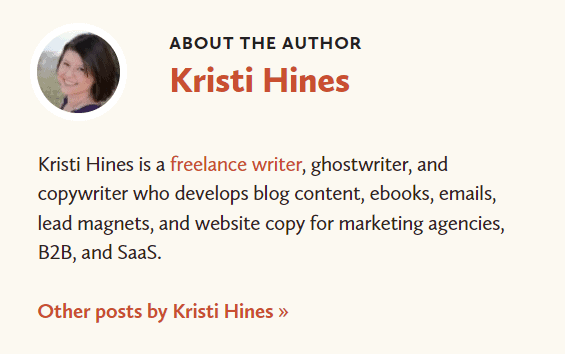
You can find guest posting opportunities by reaching out to other bloggers in your niche or by doing a simple Google search.
7. Monetize & Make Money
Now that you have started getting traffic to your mental health blog, it’s time to start monetizing it and making money from your blog.
Advertising
One of the simplest ways to make money from your mental health blog is to advertise on your blog.
You can do this by signing up for an ad network. You will get paid when someone views or clicks on ads on your blog.
To start advertising on your blog, you can sign up for an ad network like Ezoic (they pay more than Google Adsense). When your blog starts getting more than 100,000 page views a month you can monetize with Adthrive.
| Ad Network | Earnings Per 1K Impressions (EPM) | Monthly Traffic Requirement |
|---|---|---|
| Ad Thrive | $13 | 100,000 |
| Ezoic | $3 | 10,000 |
| Media.net | $1 | – |
| Google Adsense | $1 | – |
Sell Courses/E-Books
You can create a course or e-book around a core topic that your audience is interested in and sell it on your mental health blog.
This is a great way to make money from your blog and it will supplement the money you make from ads and affiliate marketing.
You can use Teachable if you want to sell video courses. Your students will have a dedicated course members area and a community system to ask questions and interact with each other. If you only want to sell eBooks, you can use SendOwl which lets you sell your digital products and eBooks for free.
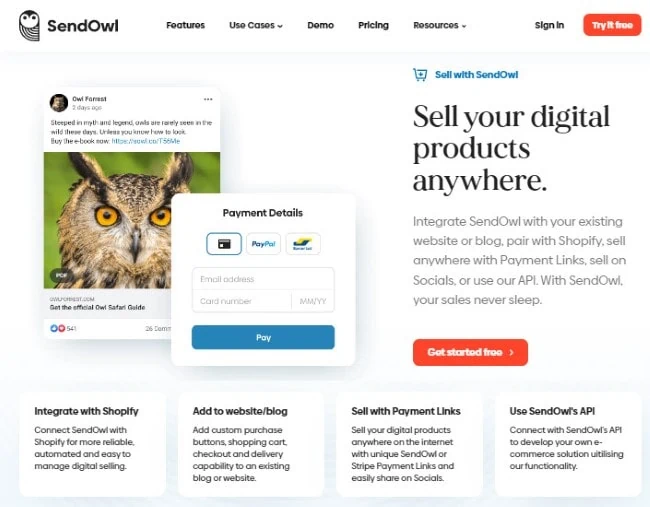
Affiliate Marketing
Affiliate marketing is when you promote someone else’s product or service and earn a commission for each sale you generate.
This is a great way to make money from your mental health blog because you can promote products that are relevant to your niche and earn a commission for each sale.
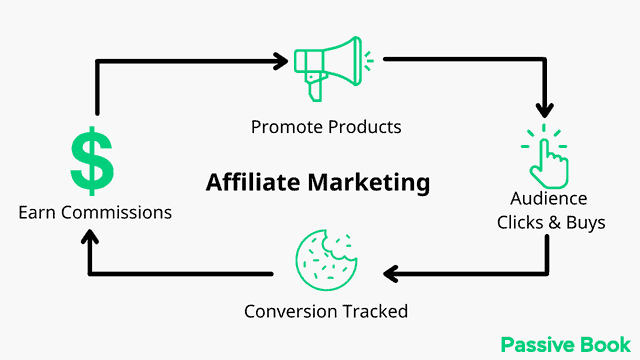
If you ever write about a product or service, check if they have an affiliate or referral program. If they do, then just link to their program from your post.
Sell Services
If you offer services you can promote them in your mental health blog.
You can offer one-on-one therapy sessions or group therapy sessions. You can also offer other services like coaching or consulting for bloggers or therapists.
This is a great way to make money from your mental health blog.
Sponsored Post
Mental health blogs can make money with sponsored posts by building relationships with brands and companies that align with their blog’s mission. The blogger should research potential sponsors and create a media kit that outlines the blog’s reach, audience, and content. This will help the blogger present their blog in an attractive way to potential sponsors.
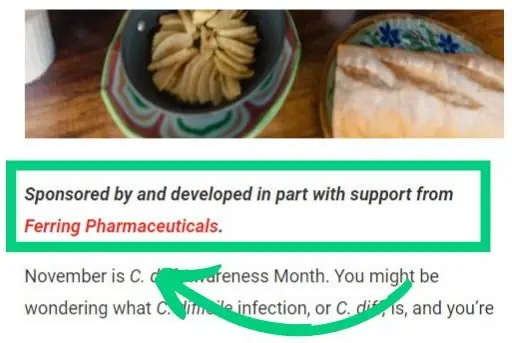
The blogger should also be clear about the types of sponsored content they are willing to accept. Many bloggers prefer to work with brands for which they have a natural affinity, so this is an important factor when considering what type of sponsored posts to accept. Additionally, the blogger should be transparent about any sponsored posts they do accept and disclose any partnership or sponsorship agreements in accordance with FTC guidelines.
Finally, mental health bloggers need to develop a pricing structure for sponsored posts that reflects the value of their content and reach.
FAQ
Here are a few frequently asked questions:
Can you make a blog about mental health?
Yes, you can make a blog about mental health. Many mental health blogs are extremely popular.
How do I create a mental health website?
You can create a mental health website by using WordPress. Follow the steps in this guide to create one.
What are mental health blogs?
Mental health blogs are blogs that focus on topics related to mental health. These blogs can be about personal experiences, mental health tips, or anything else related to mental health.
Do mental health blogs make money?
Yes, mental health blogs can make money. You can make money from your mental health blog by selling advertising space, affiliate products, or offering services.
What is the best way to promote my Mental Health blog?
The best way to promote your mental health blog is to use SEO, use social media, and write guest post on other blogs.
How often should I post on my Mental Health blog?
It depends on your goals, but we recommend posting 1-2 times per week.
How long should my Mental Health blog posts be?
It depends on your goals, but we recommend writing posts that are at least 1,000 words.
What Next?
Are you ready to become a mental health blogger?
If you have any questions as you set up your new blog, leave a comment below so we can help you out.
Your new mental health blog can be a great way to help others who are struggling with their mental health. It can also be extremely therapeutic for you and will be a great way to make a full-time passive income online.
Have you started your mental health blog yet? What type of mental health blog are you going to start? Let us know in the comments.
Share this post with your friends & followers:
